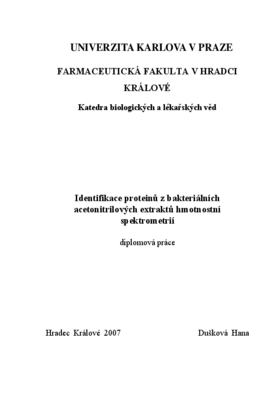Identifikace proteinů z bakteriálních acetonitrilových extraktů hmotnostní spektrometrii
Identifikation of proteins of bacterial acetonitrile extracts by mass spectrometry.
diplomová práce (OBHÁJENO)

Zobrazit/
Trvalý odkaz
http://hdl.handle.net/20.500.11956/10741Identifikátory
SIS: 17679
Kolekce
- Kvalifikační práce [6722]
Autor
Vedoucí práce
Oponent práce
Pávková, Ivona
Fakulta / součást
Farmaceutická fakulta v Hradci Králové
Obor
Farmacie
Katedra / ústav / klinika
Katedra biologických a lékařských věd
Datum obhajoby
4. 6. 2007
Nakladatel
Univerzita Karlova, Farmaceutická fakulta v Hradci KrálovéJazyk
Čeština
Známka
Výborně
SOUHRN V diplomové práci nazvané "Identifikace proteinů acetonitrilových extraktů hmotnostní spektrometrií" byla provedena detekce a identifikace biologického agens, intracelulární bakterie Coxiella burnetii. Detekce a identifikace proteinů byla provedena pomocí různých proteomických přístupů založených na kombinaci separačních technik (2D elektoforéza nebo HPLC) s hmotnostní spektrometrií. Pro rychlou detekci bakterie Coxilla burnetii byla nejvhodnější analýza bakteriálního acetonitrilového extraktu měřená na hmotnostním spektrometru MALDI-TOF v lineárním módu. Ostatní proteomické přístupy poskytly reprodukovatelné výsledky vedoucí k identifikaci 6 proteinů: chaperonový DnaK (heat shock 70 K protein), chaperoninový 60 K (GroEL protein, heat shock protein B), DnaJ protein (mucoidy activation protein muc Z), elongační faktor Ts (EF-Ts), ribozomální protein L7/L12 a chaperoninový 10 K (GroES protein, heat shock protein A).
The main goal of diploma paper entitled: "Mass spectrometry identification of bacterial proteins obtained from acetonitrile extracts" was detection and identification of biological agents, intracellular bacteria Coxiella burnetii. Different proteomic approaches combining separation technology (2D electrophoresis or HPLC) with mass spectrometry analysis, provide sufficient capabilities for detection and identification of proteins. Analyses of bacterial acetonitrile extract in linear mod by MALDI-TOF mass spectrometer were suitable for rapid detection of Coxiella burnetii. Other proteomic approaches (in gel or gel free methods) offered reproducible identification of 6 proteins: chaperone DnaK (heat shock 70 K protein), chaperonin 60 K (GroEL protein, heat shock protein B), DnaJ protein (mucoidy activation protein muc Z), elongation factor Ts (EF-Ts), ribosomal protein L7/L12, and chaperonine 10 K (GroES protein, heat shock protein A).
